Twig and Shoot Dieback of Citrus, a New Disease Caused by Colletotrichum Species
Abstract
1. Introduction
2. Materials and Methods
2.1. Sampling and Isolation
2.2. Fungal Isolates
2.3. Morphological Characteristics and Optimum Growth Temperature of Isolates
2.4. DNA Extraction, PCR Amplification and Sequencing
2.5. Pathogenicity Test
2.6. Statistical Analysis
3. Results
4. Discussion
5. Conclusions
Author Contributions
Funding
Institutional Review Board Statement
Informed Consent Statement
Data Availability Statement
Acknowledgments
Conflicts of Interest
References
- Shkreli, E.; Imami, D. Citrus Sector Study; ASF Project Office: Tiranë, Albania, 2019. [Google Scholar]
- Istat.it. Available online: http://dati.istat.it/Index.aspx?QueryId=33705 (accessed on 18 September 2020).
- Sinab.it. Available online: http://www.sinab.it/node/22428 (accessed on 18 September 2020).
- Cacciola, S.O.; Gullino, M.L. Emerging and re-emerging fungus and oomycete soil-borne plant diseases in Italy. Phytopathol. Mediterr. 2019, 58, 451–472. [Google Scholar]
- Mayorquin, J.S.; Nouri, M.T.; Peacock, B.B.; Trouillas, F.P.; Douhan, G.W.; Kallsen, C.; Eskalen, A. Identification, Pathogenicity, and Spore Trapping of Colletotrichum karstii Associated with Twig and Shoot Dieback in California. Plant Dis. 2019, 103, 1464–1473. [Google Scholar] [CrossRef] [PubMed]
- Eskalen, A.; Dohuan, G.W.; Craig, K.; Mayorquin, J.S. Colletotrichum dieback of mandarins and Navel oranges in California: A new twig and shoot disease in the Central Valley. Citrograph 2019, 10, 50–54. [Google Scholar]
- Benyahia, H.; Ifia, A.; Smaili, C.; Afellah, M.; Lamsetef, Y.; Timmer, L.W.; Ifi, A. First report of Colletotrichum gloeosporioides causing withertip on twigs and tear stain on fruit of citrus in Morocco. Plant Pathol. 2003, 52, 798. [Google Scholar] [CrossRef]
- Rhaiem, A.; Taylor, P.W.J. Colletotrichum gloeosporioides associated with anthracnose symptoms on citrus, a new report for Tunisia. Eur. J. Plant Pathol. 2016, 146, 219–224. [Google Scholar] [CrossRef]
- Mahiout, D.; Bendahmane, B.S.; Youcef Benkada, M.; Mekouar, H.; Berrahal, N.; Rickauer, M. First report of Colletotrichum gloeosporioides on citrus in Algeria. Phytopathol. Mediterr. 2018, 57, 355–359. [Google Scholar]
- Ramos, A.P.; Talhinhas, P.; Sreenivasaprasad, S.; Oliveira, H. Characterization of Colletotrichum gloeosporioides, as the main causal agent of citrus anthracnose, and C. karstii as species preferentially associated with lemon twig dieback in Portugal. Phytoparasitica 2016, 44, 549–561. [Google Scholar] [CrossRef]
- Dowling, M.; Peres, N.; Villani, S.; Schnabel, G. Managing Colletotrichum on fruit crops: A “complex” challenge. Plant Dis. 2020, 104, 2301–2316. [Google Scholar] [CrossRef]
- Brown, A.E.; Sreenivasaprasad, S.; Timmer, L.W. Molecular characterization of slow-growing orange and key lime anthracnose strains of Colletotrichum from citrus as C. acutatum. Phytopathology 1996, 86, 523–527. [Google Scholar] [CrossRef]
- Peres, N.A.; Timmer, L.W.; Adaskaveg, J.E.; Correll, J.C. Lifestyles of Colletotrichum acutatum. Plant Dis. 2005, 89, 784–796. [Google Scholar] [CrossRef]
- Damm, U.; Cannon, P.; Woudenberg, J.; Johnston, P.; Weir, B.; Tan, Y.; Shivas, R.; Crous, P. The Colletotrichum boninense species complex. Stud. Mycol. 2012, 73, 1–36. [Google Scholar] [CrossRef] [PubMed]
- Bragança, C.A.; Damm, U.; Baroncelli, R.; Júnior, N.S.M.; Crous, P.W. Species of the Colletotrichum acutatum complex associated with anthracnose diseases of fruit in Brazil. Fungal Biol. 2016, 120, 547–561. [Google Scholar] [CrossRef]
- Savi, D.C.; Rossi, B.J.; Rossi, G.R.; Ferreira-Maba, L.S.; Bini, I.H.; Trindade, E.D.S.; Goulin, E.H.; Machado, M.A.; Glienke, C. Microscopic analysis of colonization of Colletotrichum abscissum in citrus tissues. Microbiol. Res. 2019, 226, 27–33. [Google Scholar] [CrossRef]
- Guarnaccia, V.; Groenewald, J.; Polizzi, G.; Crous, P. High species diversity in Colletotrichum associated with citrus diseases in Europe. Persoonia 2017, 39, 32–50. [Google Scholar] [CrossRef] [PubMed]
- Moges, A.; Belew, D.; Admassu, B.; Yesuf, M.; Maina, S.; Ghimire, S. Frequent association of Colletotrichum species with citrus fruit and leaf spot disease symptoms and their genetic diversity in Ethiopia. J. Plant Pathol. Microbiol. 2017, 8. [Google Scholar] [CrossRef]
- Ben Hadj Daoud, H.; Baraldi, E.; Iotti, M.; Leonardi, P.; Boughalleb-M’Hamdi, N. Characterization and pathogenicity of Colletotrichum spp. causing citrus anthracnose in Tunisia. Phytopathol. Mediterr. 2019, 58, 175–185. [Google Scholar]
- Uysal, A.; Kurt, Ş. First report of Colletotrichum karstii causing anthracnose on citrus in the Mediterranean region of Turkey. J. Plant Pathol. 2019, 101, 753. [Google Scholar] [CrossRef]
- Lima, W.G.; Spósito, M.B.; Amorim, L.; Gonçalves, F.P.; De Filho, P.A.M. Colletotrichum gloeosporioides, a new causal agent of citrus post-bloom fruit drop. Eur. J. Plant Pathol. 2011, 131, 157–165. [Google Scholar] [CrossRef]
- Damm, U.; Cannon, P.; Woudenberg, J.; Crous, P. The Colletotrichum acutatum species complex. Stud. Mycol. 2012, 73, 37–113. [Google Scholar] [CrossRef]
- Weir, B.; Johnston, P.; Damm, U. The Colletotrichum gloeosporioides species complex. Stud. Mycol. 2012, 73, 115–180. [Google Scholar] [CrossRef]
- Peng, L.; Yang, Y.; Hyde, K.D.; Bahkali, A.H.; Liu, Z. Colletotrichum species on Citrus leaves in Guizhou and Yunnan provinces, China. Cryptogam. Mycol. 2012, 33, 267–283. [Google Scholar]
- Huang, F.; Chen, G.Q.; Hou, X.; Fu, Y.S.; Cai, L.; Hyde, K.D.; Li, H.Y. Colletotrichum species associated with cultivated citrus in China. Fungal Divers. 2013, 61, 61–74. [Google Scholar] [CrossRef]
- Schena, L.; Mosca, S.; Cacciola, S.O.; Faedda, R.; Sanzani, S.M.; Agosteo, G.E.; Sergeeva, V.; Magnano di San Lio, G. Species of the Colletotrichum gloeosporioides and C. boninense complexes associated with olive anthracnose. Plant Pathol. 2014, 63, 437–446. [Google Scholar] [CrossRef]
- Aiello, D.; Carrieri, R.; Guarnaccia, V.; Vitale, A.; Lahoz, E.; Polizzi, G. Characterization and Pathogenicity of Colletotrichum gloeosporioides and C. karstii Causing Preharvest Disease on Citrus sinensis in Italy. J. Phytopathol. 2015, 163, 168–177. [Google Scholar] [CrossRef]
- Taheri, H.; Javan-Nikkhah, M.; Elahinia, S.A.; Khodaparast, S.A.; Golmohammadi, M. Species of Colletotrichum associated with citrus trees in Iran. Mycol. Iran. 2016, 3, 1–14. [Google Scholar]
- Faedda, R.; Agosteo, G.E.; Schena, L.; Mosca, S.; Frisullo, S.; Magnano Di San Lio, G.; Cacciola, S.O. Colletotrichum clavatum sp. nov. identified as the causal agent of olive anthracnose in Italy. Phytopathol. Mediterr. 2011, 50, 283–302. [Google Scholar]
- Cacciola, S.O.; Gilardi, G.; Faedda, R.; Schena, L.; Pane, A.; Garibaldi, A.; Gullino, M.L. Characterization of Colletotrichum ocimi Population Associated with Black Spot of Sweet Basil in Northern Italy. Plants 2020, 9, 654. [Google Scholar] [CrossRef]
- ChromasPro v. 1.5 Software. Available online: http://www.technelysium.com.au/ (accessed on 15 October 2020).
- Shivas, R.G.; Tan, Y.P. A taxonomic re-assesment of Colletotrichum acutatum, introducing C. fioriniae comb. at stat. nov. and C. simmondsii sp. nov. Fungal Divers. 2009, 39, 111–112. [Google Scholar]
- Uematsu, S.; Kageyama, K.; Moriwaki, J.; Sato, T. Colletotrichum carthami comb. nov., an anthracnose pathogen of safflower, garland chrysanthemum and pot marigold, revived by molecular phylogeny with authentic herbarium specimens. J. Gen. Plant Pathol. 2012, 78, 316–330. [Google Scholar] [CrossRef]
- Lubbe, C.M.; Denman, S.; Cannon, P.F.; Groenewald, J.Z.; Lamprecht, S.C.; Crous, P.W. Characterization of Colletotrichum Species Associated with Diseases of Proteaceae. Mycologia 2004, 96, 1268–1279. [Google Scholar] [CrossRef]
- Yang, Y.; Cal, L.; Yu, Z.; Liu, Z.; Hyde, K.D. Colletotrichum species on Orchidaceae in Southwest China. Cryptogam. Mycol. 2011, 32, 229–253. [Google Scholar]
- Cannon, P.F.; Damm, U.; Johnston, P.R.; Weir, B.S. Colletotrichum—Current status and future directions. Stud. Mycol. 2012, 73, 181–213. [Google Scholar] [CrossRef]
- TOPALi v2. Available online: http://www.topali.org/ (accessed on 15 October 2020).
- Freeman, S.; Katan, T.; Shabi, E. Characterization of Colletotrichum Species Responsible for Anthracnose Diseases of Various Fruits. Plant Dis. 1998, 82, 596–605. [Google Scholar] [CrossRef]
- R Core Team. R: A Language and Environment for Statistical Computing; R Foundation for Statistical Computing: Vienna, Austria, 2018; Available online: https://www.R-project.org (accessed on 18 October 2020).
- Timmer, L.W.; Brown, G.E. Biology and control of anthracnose diseases of citrum. In Host Specificity; Prusky, D., Freeman, S., Dickman, M.B., Eds.; The American Phytopathological Society: St. Paul, MN, USA, 2000; pp. 300–316. [Google Scholar]
- Phoulivong, S.; Cai, L.; Chen, H.; McKenzie, E.H.C.; Abdelsalam, K.; Chukeatirote, E.; Hyde, K.D. Colletotrichum gloeosporioides is not a common pathogen on tropical fruits. Fungal Divers. 2010, 44, 33–43. [Google Scholar] [CrossRef]
- Douanla-Meli, C.; Unger, J.-G. Phylogenetic study of the Colletotrichum species on imported citrus fruits uncovers a low diversity and a new species in the Colletotrichum gigasporum complex. Fungal Biol. 2017, 121, 858–868. [Google Scholar] [CrossRef]
- Abdelfattah, A.; Nicosia, M.G.L.D.; Cacciola, S.O.; Droby, S.; Schena, L. Metabarcoding Analysis of Fungal Diversity in the Phyllosphere and Carposphere of Olive (Olea europaea). PLoS ONE 2015, 10, e0131069. [Google Scholar] [CrossRef] [PubMed]
- Peres, N.A.; MacKenzie, S.J.; Peever, T.L.; Timmer, L.W. Postbloom Fruit Drop of Citrus and Key Lime Anthracnose Are Caused by Distinct Phylogenetic Lineages of Colletotrichum acutatum. Phytopathology 2008, 98, 345–352. [Google Scholar] [CrossRef]
- Mosca, S.; Nicosia, M.G.L.D.; Cacciola, S.O.; Schena, L. Molecular Analysis of Colletotrichum Species in the Carposphere and Phyllosphere of Olive. PLoS ONE 2014, 9, e114031. [Google Scholar] [CrossRef] [PubMed]
- Schena, L.; Abdelfattah, A.; Mosca, S.; Nicosia, M.G.L.D.; Agosteo, G.E.; Cacciola, S.O. Quantitative detection of Colletotrichum godetiae and C. acutatum sensu stricto in the phyllosphere and carposphere of olive during four phenological phases. Eur. J. Plant Pathol. 2017, 149, 337–347. [Google Scholar] [CrossRef]
- Pangallo, S.; Nicosia, M.G.L.D.; Agosteo, G.E.; Abdelfattah, A.; Romeo, F.V.; Cacciola, S.O.; Rapisarda, P.; Schena, L. Evaluation of a Pomegranate Peel Extract as an Alternative Means to Control Olive Anthracnose. Phytopathology 2017, 107, 1462–1467. [Google Scholar] [CrossRef] [PubMed]
- Crous, P.W.; Groenewald, J.Z.; Slippers, B.; Wingfield, M.J. Global food and fibre security threatened by current inefficiencies in fungal identification. Philos. Trans. R. Soc. B Biol. Sci. 2016, 371, 20160024. [Google Scholar] [CrossRef] [PubMed]
- Yaseen, T.; D’Onghia, A. Fusarium spp. Associated to citrus dry root rot: An emerging issue for mediterranean citriculture. Acta Hortic. 2012, 940, 647–655. [Google Scholar] [CrossRef]
- Adesemoye, A.; Eskalen, A.; Faber, B.; Bender, G.; Connell, N.O.; Kallsen, C.; Shea, T. Current knowledge on Fusarium dry rot of citrus. Citrograph 2011, 2, 29–33. [Google Scholar]
- Sandoval-Denis, M.; Guarnaccia, V.; Polizzi, G.; Crous, P. Symptomatic Citrus trees reveal a new pathogenic lineage in Fusarium and two new Neocosmospora species. Persoonia 2018, 40, 1–25. [Google Scholar] [CrossRef] [PubMed]
- Li, T.; Fan, P.; Yun, Z.; Jiang, G.; Zhang, Z.; Jiang, Y. β-Aminobutyric Acid Priming Acquisition and Defense Response of Mango Fruit to Colletotrichum gloeosporioides Infection Based on Quantitative Proteomics. Cells 2019, 8, 1029. [Google Scholar] [CrossRef] [PubMed]
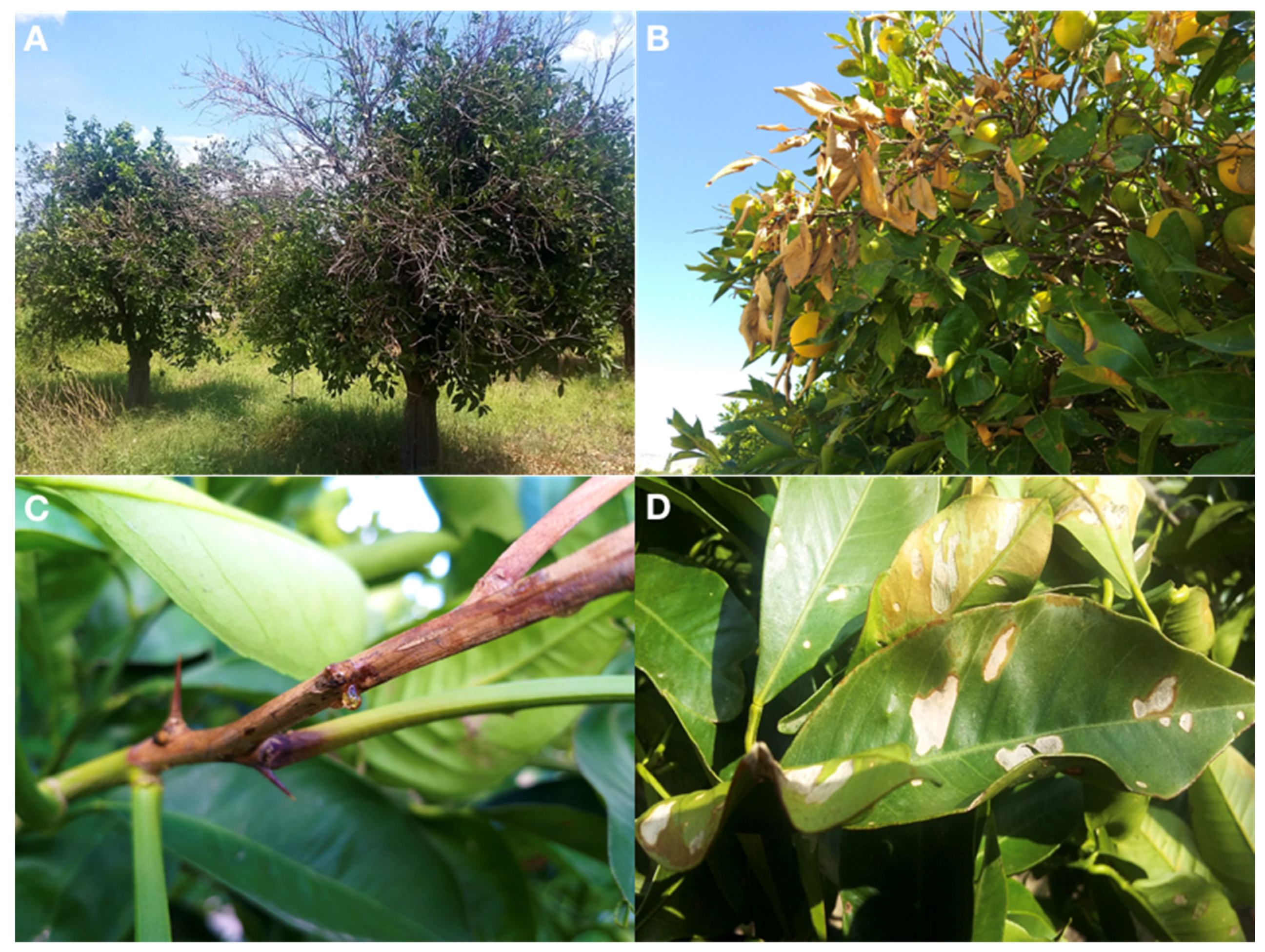
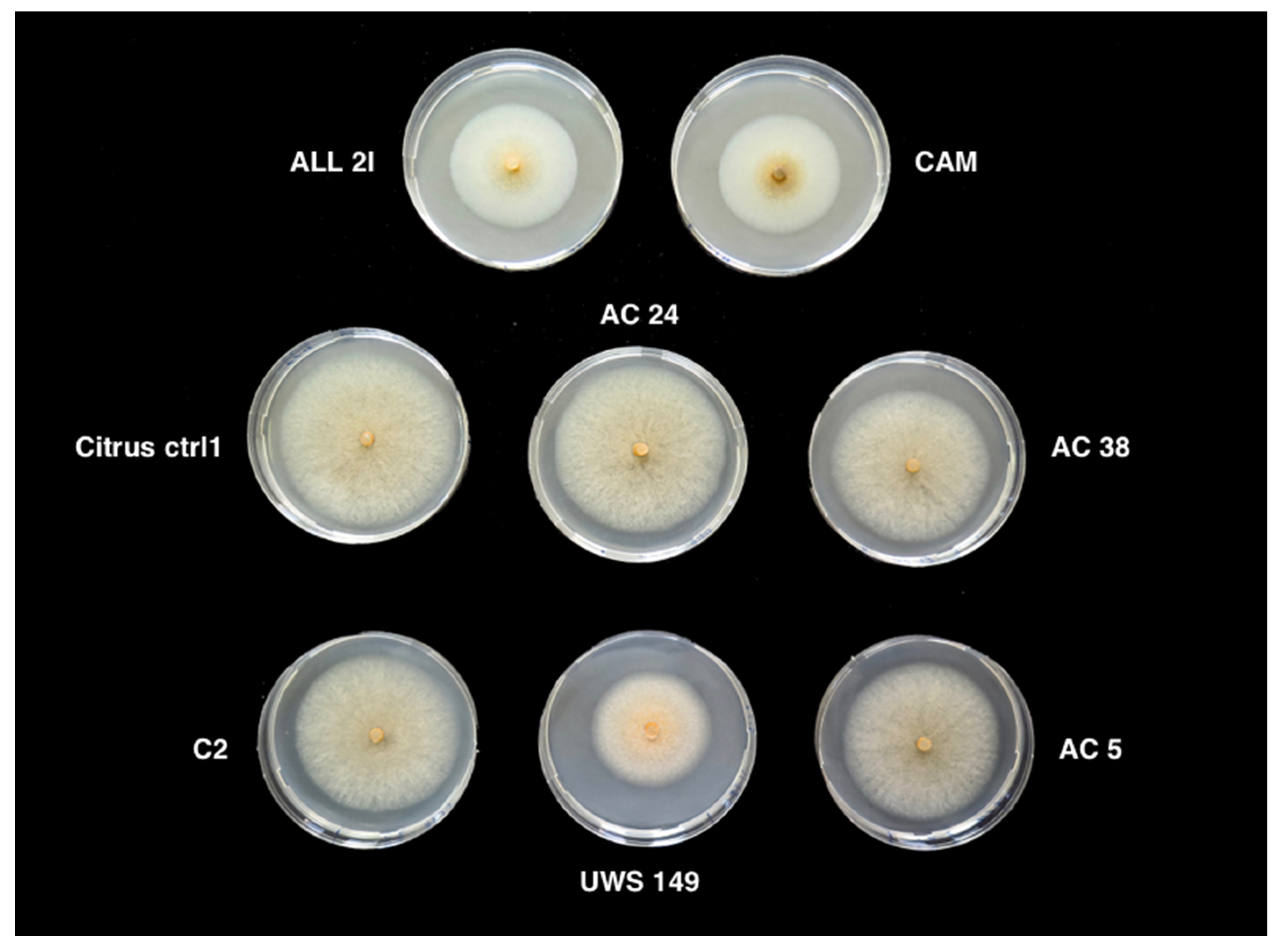


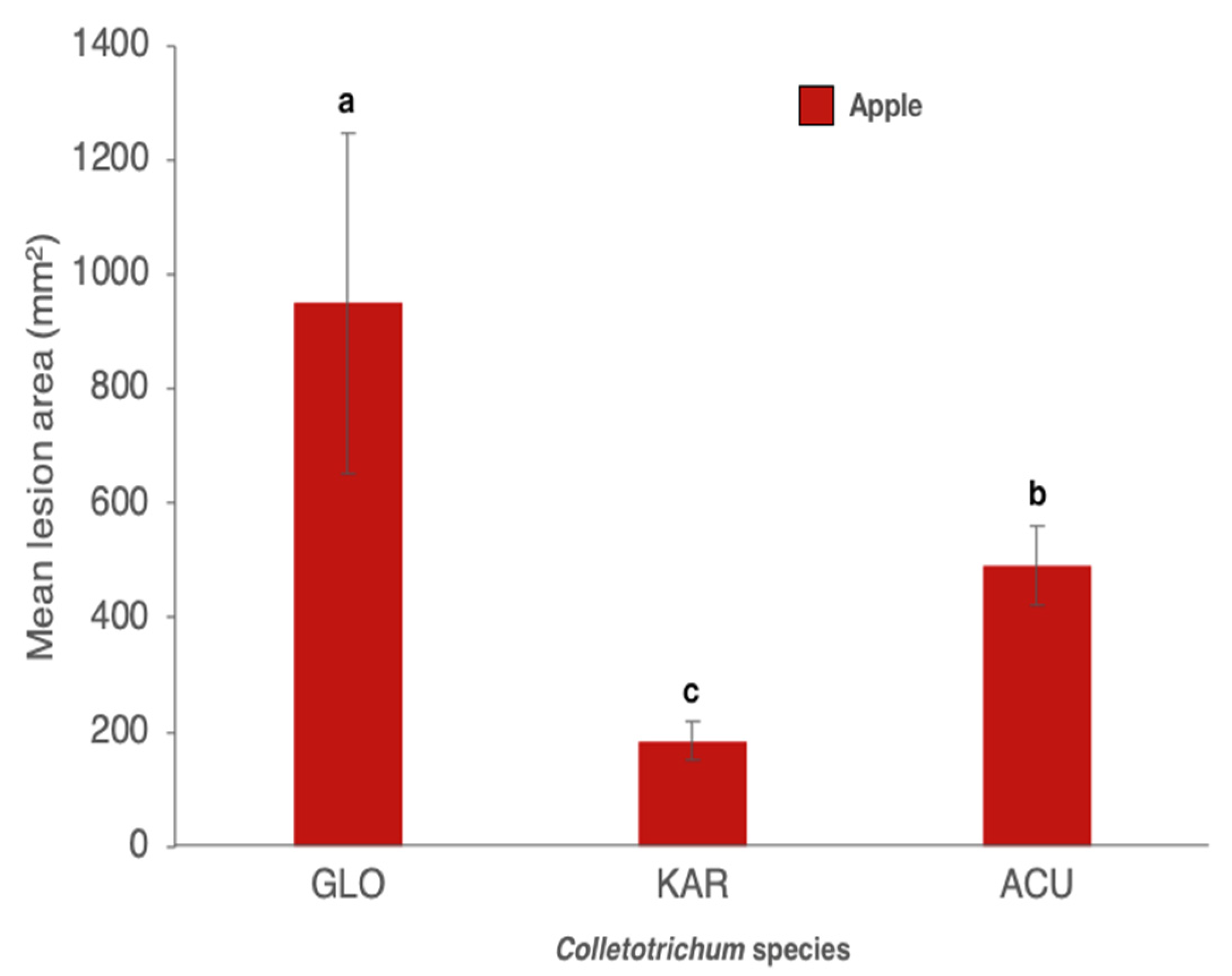
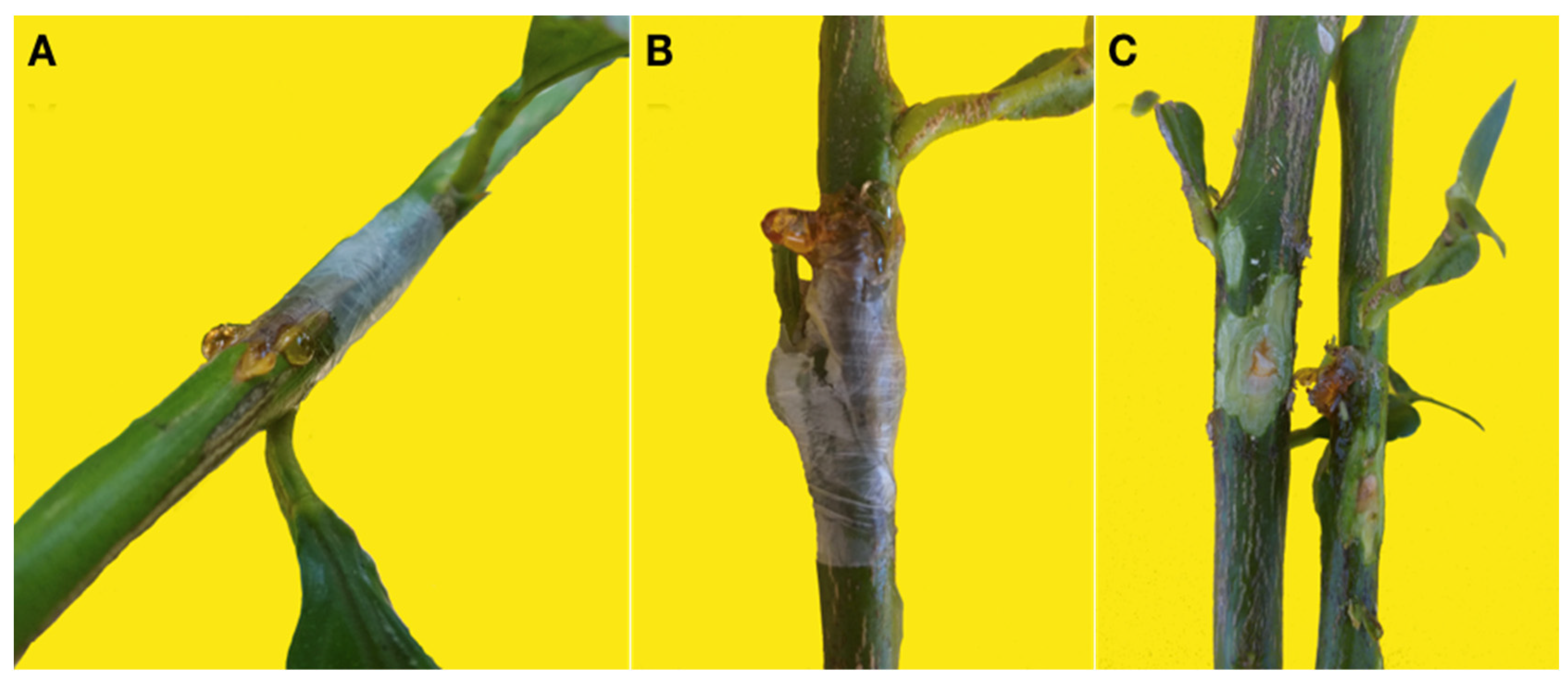
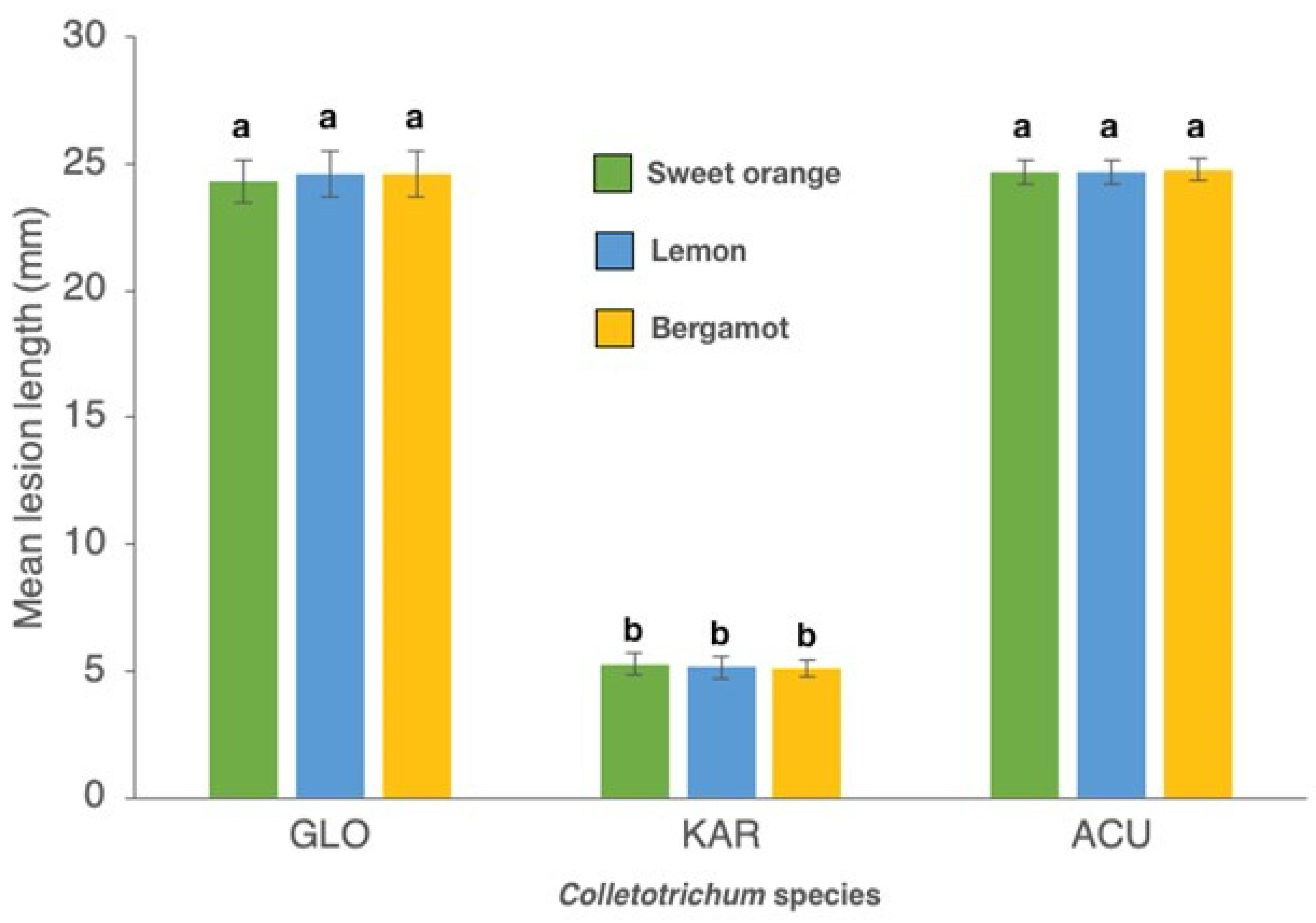
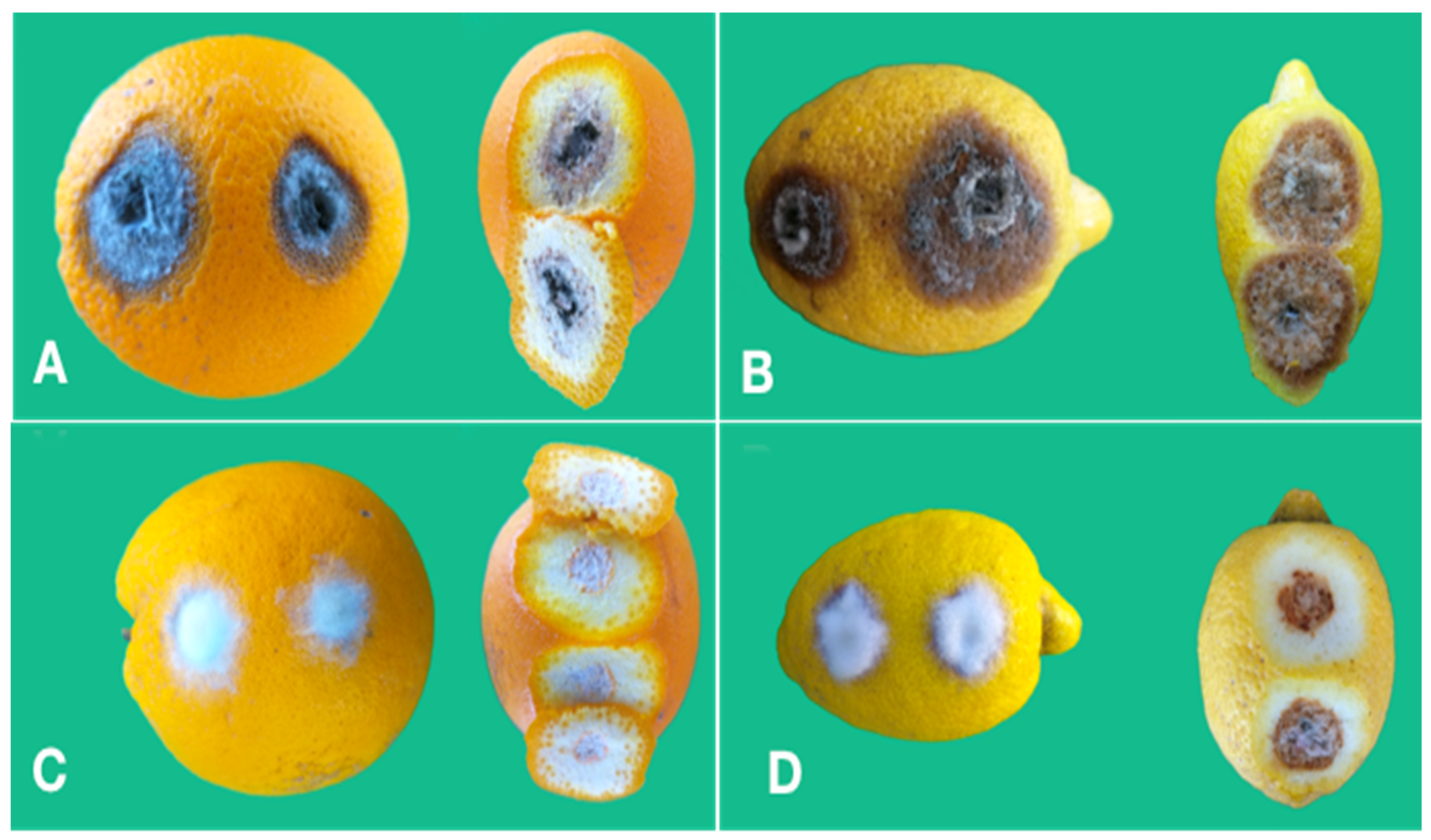
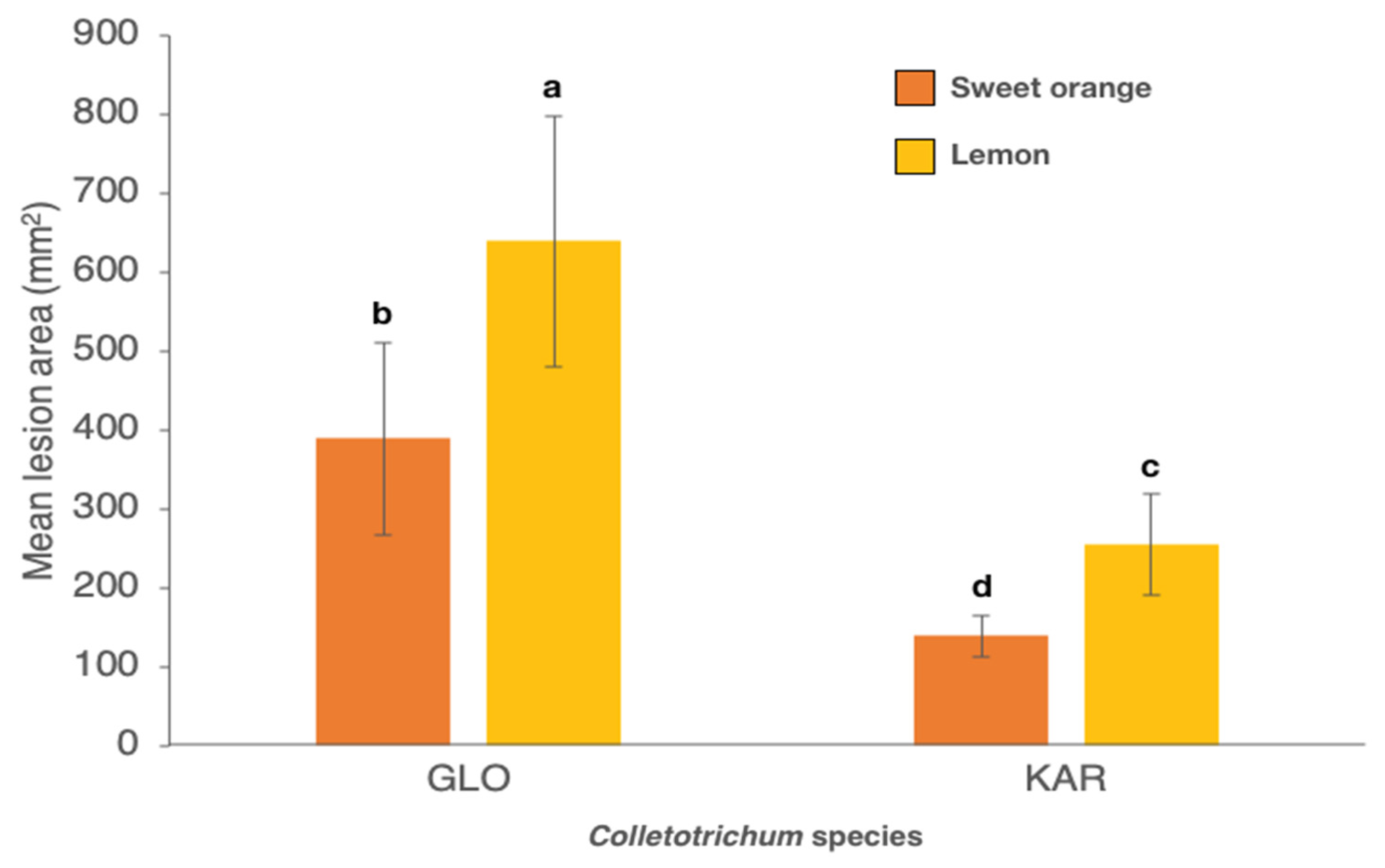

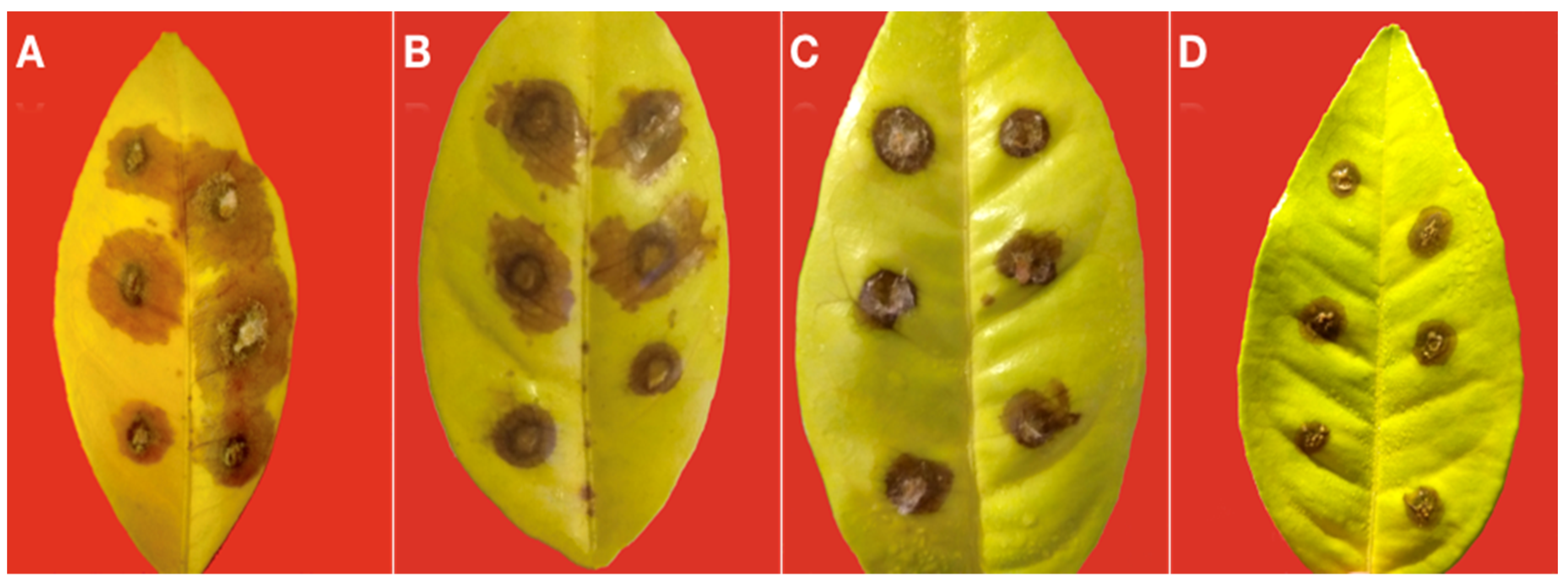
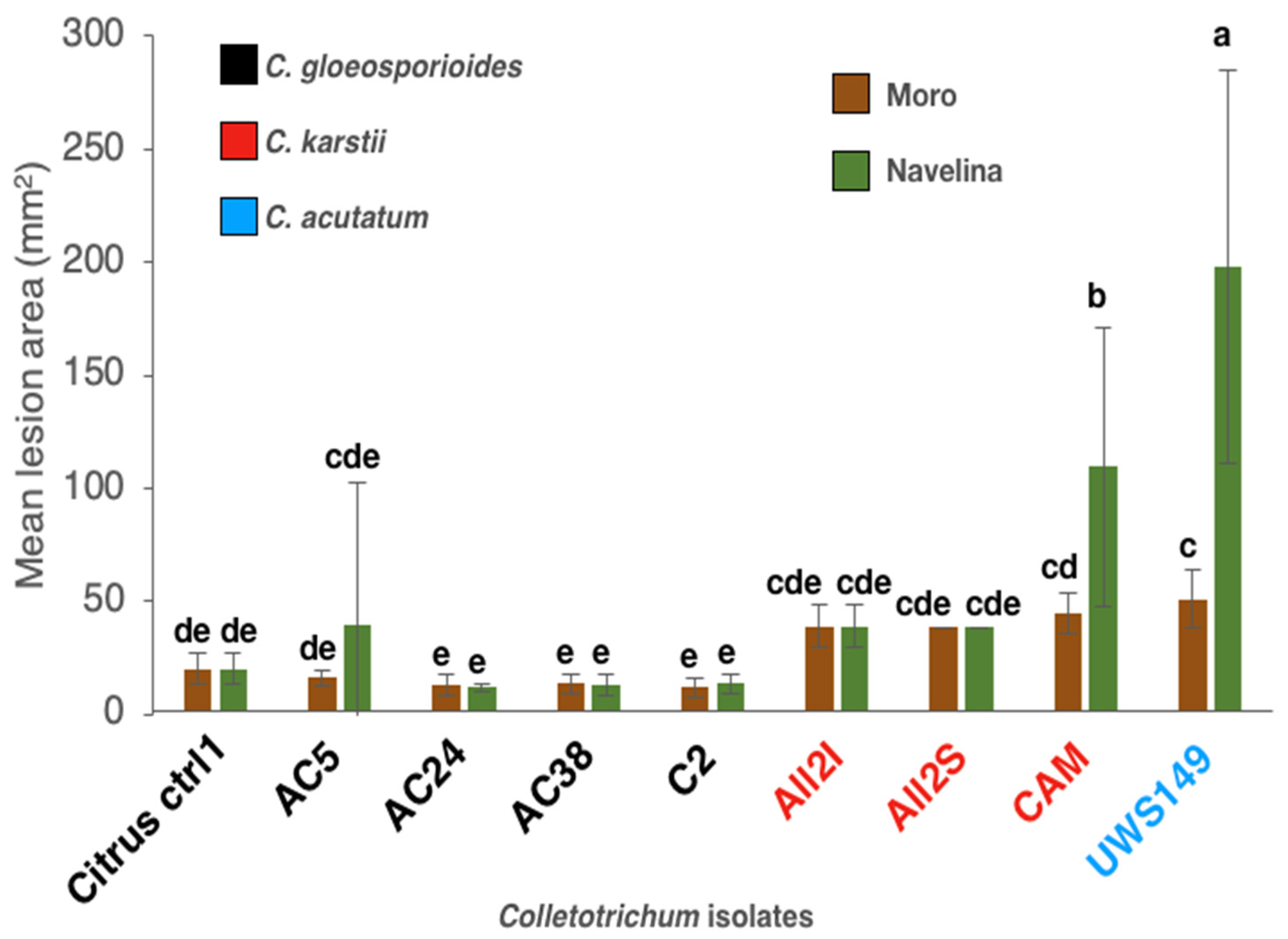
| Isolate Code | Species | Host (Species and Cultivar) | Organ | Geographical Origin | Genbank Accession | |
|---|---|---|---|---|---|---|
| ITS-rDNA | β-tubulin 2 | |||||
| AC1 | C. gloeosporioides | Sweet orange ‘Tarocco Lempso’ | twig | Ramacca (Ct)-Sicily | MT997785 | MW001517 |
| AC2 | C. gloeosporioides | Sweet orange ‘Tarocco Lempso’ | twig | Ramacca (Ct)-Sicily | MT997786 | MW001518 |
| AC3 | C. gloeosporioides | Sweet orange ‘Tarocco Lempso’ | twig | Ramacca (Ct)-Sicily | MT997787 | MW001519 |
| AC4 | C. gloeosporioides | Sweet orange ‘Tarocco Lempso’ | twig | Ramacca (Ct)-Sicily | MT997788 | MW001520 |
| AC5 | C. gloeosporioides | Sweet orange ‘Tarocco Lempso’ | twig | Ramacca (Ct)-Sicily | MT997789 | MW001521 |
| AC6 | C. gloeosporioides | Sweet orange ‘Tarocco Lempso’ | twig | Ramacca (Ct)-Sicily | MT997790 | MW001522 |
| AC7 | C. gloeosporioides | Sweet orange ‘Tarocco Lempso’ | twig | Ramacca (Ct)-Sicily | MT997791 | MW001523 |
| AC8 | C. gloeosporioides | Sweet orange ‘Tarocco Lempso’ | twig | Ramacca (Ct)-Sicily | MT997792 | MW001524 |
| AC9 | C. gloeosporioides | Sweet orange ‘Tarocco Lempso’ | twig | Ramacca (Ct)-Sicily | MT997793 | MW001525 |
| AC10 | C. gloeosporioides | Sweet orange ‘Tarocco Lempso’ | twig | Ramacca (Ct)-Sicily | MT997794 | MW001526 |
| AC11 | C. gloeosporioides | Sweet orange ‘Tarocco Lempso’ | twig | Ramacca (Ct)-Sicily | MT997795 | MW001527 |
| AC12 | C. gloeosporioides | Sweet orange ‘Tarocco Lempso’ | twig | Ramacca (Ct)-Sicily | MT997796 | MW001528 |
| AC13 | C. gloeosporioides | Sweet orange ‘Tarocco Lempso’ | twig | Ramacca (Ct)-Sicily | MT997797 | MW001529 |
| AC14 | C. gloeosporioides | Sweet orange ‘Tarocco Lempso’ | twig | Ramacca (Ct)-Sicily | MT997798 | MW001530 |
| AC15 | C. gloeosporioides | Sweet orange ‘Tarocco Lempso’ | twig | Ramacca (Ct)-Sicily | MT997799 | MW001531 |
| AC16 | C. gloeosporioides | Sweet orange ‘Tarocco Lempso’ | twig | Ramacca (Ct)-Sicily | MT997800 | MW001532 |
| AC17 | C. gloeosporioides | Sweet orange ‘Tarocco Lempso’ | twig | Ramacca (Ct)-Sicily | MT997801 | MW001533 |
| AC18 | C. gloeosporioides | Sweet orange ‘Tarocco Lempso’ | twig | Ramacca (Ct)-Sicily | MT997802 | MW001534 |
| AC19 | C. gloeosporioides | Sweet orange ‘Tarocco Lempso’ | twig | Ramacca (Ct)-Sicily | MT997803 | MW001535 |
| AC20 | C. gloeosporioides | Sweet orange ‘Tarocco Lempso’ | twig | Ramacca (Ct)-Sicily | MT997804 | MW001536 |
| AC21 | C. gloeosporioides | Sweet orange ‘Tarocco Lempso’ | twig | Ramacca (Ct)-Sicily | MT997805 | MW001537 |
| AC22 | C. gloeosporioides | Sweet orange ‘Tarocco Lempso’ | twig | Ramacca (Ct)-Sicily | MT997806 | MW001538 |
| AC23 | C. gloeosporioides | Sweet orange ‘Tarocco Lempso’ | twig | Ramacca (Ct)-Sicily | MT997807 | MW001539 |
| AC24 | C. gloeosporioides | Sweet orange ‘Tarocco Lempso’ | twig | Ramacca (Ct)-Sicily | MT997808 | MW001540 |
| AC25 | C. gloeosporioides | Sweet orange ‘Tarocco Lempso’ | twig | Ramacca (Ct)-Sicily | MT997809 | MW001541 |
| AC26 | C. gloeosporioides | Sweet orange ‘Tarocco Lempso’ | twig | Ramacca (Ct)-Sicily | MT997810 | MW001542 |
| AC27 | C. gloeosporioides | Sweet orange ‘Tarocco Lempso’ | twig | Ramacca (Ct)-Sicily | MT997811 | MW001543 |
| AC28 | C. gloeosporioides | Sweet orange ‘Tarocco Lempso’ | twig | Ramacca (Ct)-Sicily | MT997812 | MW001544 |
| AC29 | C gloeosporioides. | Sweet orange ‘Tarocco Lempso’ | twig | Ramacca (Ct)-Sicily | MT997813 | MW001545 |
| AC30 | C. gloeosporioides | Sweet orange ‘Tarocco Lempso’ | twig | Ramacca (Ct)-Sicily | MT997814 | MW001546 |
| AC31 | C. gloeosporioides | Sweet orange ‘Tarocco Lempso’ | twig | Ramacca (Ct)-Sicily | MT997815 | MW001547 |
| AC32 | C. gloeosporioides | Sweet orange ‘Tarocco Lempso’ | twig | Ramacca (Ct)-Sicily | MT997816 | MW001548 |
| AC33 | C. gloeosporioides | Sweet orange ‘Tarocco Lempso’ | twig | Ramacca (Ct)-Sicily | MT997817 | MW001549 |
| AC34 | C. gloeosporioides | Sweet orange ‘Tarocco Lempso’ | twig | Ramacca (Ct)-Sicily | MT997818 | MW001550 |
| AC35 | C. gloeosporioides | Sweet orange ‘Tarocco Lempso’ | leaf | Ramacca (Ct)-Sicily | MT997819 | MW001551 |
| AC36 | C. gloeosporioides | Sweet orange ‘Tarocco Lempso’ | leaf | Ramacca (Ct)-Sicily | MT997820 | MW001552 |
| AC37 | C. gloeosporioides | Sweet orange ‘Tarocco Lempso’ | leaf | Ramacca (Ct)-Sicily | MT997821 | MW001553 |
| AC38 | C. gloeosporioides | Sweet orange ‘Tarocco Lempso’ | leaf | Ramacca (Ct)-Sicily | MT997822 | MW001554 |
| ALL1A | C. gloeosporioides | Sweet orange ‘Lane late’ | leaf | Augusta (Sr)-Sicily | MT997843 | MW001575 |
| ALL1B | C. gloeosporioides | Sweet orange ‘Lane late’ | leaf | Augusta (Sr)-Sicily | MT997844 | MW001576 |
| ALL1C | C. gloeosporioides | Sweet orange ‘Lane late’ | leaf | Augusta (Sr)-Sicily | MT997845 | MW001577 |
| ALL1D | C. gloeosporioides | Sweet orange ‘Lane late’ | leaf | Augusta (Sr)-Sicily | MT997846 | MW001578 |
| ALL1E | C. gloeosporioides | Sweet orange ‘Lane late’ | twig | Augusta (Sr)-Sicily | MT997847 | MW001579 |
| ALL1F | C. gloeosporioides | Sweet orange ‘Lane late’ | twig | Augusta (Sr)-Sicily | MT997848 | MW001580 |
| ALL1G | C. gloeosporioides | Sweet orange ‘Lane late’ | twig | Augusta (Sr)-Sicily | MT997849 | MW001581 |
| ALL1H | C. gloeosporioides | Sweet orange ‘Lane late’ | twig | Augusta (Sr)-Sicily | MT997850 | MW001582 |
| ALL1I | C. gloeosporioides | Sweet orange ‘Lane late’ | twig | Augusta (Sr)-Sicily | MT997851 | MW001583 |
| ALL1L | C. gloeosporioides | Sweet orange ‘Lane late’ | twig | Augusta (Sr)-Sicily | MT997852 | MW001584 |
| ALL2A | C.karstii | Sweet orange ‘Lane late’ | twig | Augusta (Sr)-Sicily | MT997853 | MW001545 |
| ALL2B | C. gloeosporioides | Sweet orange ‘Lane late’ | twig | Augusta (Sr)-Sicily | MT997854 | MW001585 |
| ALL2C | C. gloeosporioides | Sweet orange ‘Lane late’ | twig | Augusta (Sr)-Sicily | MT997855 | MW001586 |
| ALL2D | C. gloeosporioides | Sweet orange ‘Lane late’ | twig | Augusta (Sr)-Sicily | MT997856 | MW001587 |
| ALL2E | C. gloeosporioides | Sweet orange ‘Lane late’ | twig | Augusta (Sr)-Sicily | MT997857 | MW001588 |
| ALL2F | C. gloeosporioides | Sweet orange ‘Lane late’ | twig | Augusta (Sr)-Sicily | MT997858 | MW001589 |
| ALL2G | C. gloeosporioides | Sweet orange ‘Lane late’ | twig | Augusta (Sr)-Sicily | MT997859 | MW001590 |
| ALL2H | C. gloeosporioides | Sweet orange ‘Lane late’ | twig | Augusta (Sr)-Sicily | MT997860 | MW001591 |
| ALL2I | C. karstii | Sweet orange ‘Lane late’ | twig | Augusta (Sr)-Sicily | MT997861 | MW001546 |
| ALL2L | C. karstii | Sweet orange ‘Lane late’ | twig | Augusta (Sr)-Sicily | MT997862 | MW001547 |
| ALL2M | C. karstii | Sweet orange ‘Lane late’ | twig | Augusta (Sr)-Sicily | MT997863 | MW001548 |
| ALL2N | C. karstii | Sweet orange ‘Lane late’ | twig | Augusta (Sr)-Sicily | MT997864 | MW001549 |
| ALL2O | C. karstii | Sweet orange ‘Lane late’ | twig | Augusta (Sr)-Sicily | MT997865 | MW001550 |
| ALL2P | C. karstii | Sweet orange ‘Lane late’ | twig | Augusta (Sr)-Sicily | MT997866 | MW001551 |
| ALL2Q | C. karstii | Sweet orange ‘Lane late’ | twig | Augusta (Sr)-Sicily | MT997867 | MW001552 |
| ALL2R | C. karstii | Sweet orange ‘Lane late’ | twig | Augusta (Sr)-Sicily | MT997868 | MW001553 |
| ALL2S | C. karstii | Sweet orange ‘Lane late’ | twig | Augusta (Sr)-Sicily | MT997869 | MW001554 |
| ALL2T | C. karstii | Sweet orange ‘Lane late’ | twig | Augusta (Sr)-Sicily | MT997870 | MW001555 |
| ALL3A | C. gloeosporioides | Sweet orange ‘Lane late’ | twig | Augusta (Sr)-Sicily | MT997871 | MW001592 |
| ALL3B | C. gloeosporioides | Sweet orange ‘Lane late’ | twig | Lentini (Sr)-Sicily | MT997872 | MW001593 |
| ALL3C | C. gloeosporioides | Sweet orange ‘Lane late’ | twig | Lentini (Sr)-Sicily | MT997873 | MW001594 |
| ALL4A | C. gloeosporioides | Sweet orange ‘Lane late’ | twig | Lentini (Sr)-Sicily | MT997874 | MW001595 |
| ALL4B | C. gloeosporioides | Sweet orange ‘Lane late’ | twig | Lentini (Sr)-Sicily | MT997875 | MW001596 |
| ALL4C | C. gloeosporioides | Sweet orange ‘Lane late’ | twig | Lentini (Sr)-Sicily | MT997876 | MW001597 |
| ALL4D | C. gloeosporioides | Sweet orange ‘Lane late’ | twig | Scordia (Ct)-Sicily | MT997877 | MW001598 |
| F169 | C. gloeosporioides | Mandarin ‘Fortune’ | twig | Scordia (Ct)-Sicily | MW506960 | MW513961 |
| F170 | C. gloeosporioides | Mandarin ‘Fortune’ | twig | Scordia (Ct)-Sicily | MW506961 | MW513962 |
| F172 | C. gloeosporioides | Mandarin ‘Fortune’ | twig | Scordia (Ct)-Sicily | MW506962 | MW513963 |
| F189 | C. gloeosporioides | Mandarin ‘Fortune’ | twig | Scordia (Ct)-Sicily | MW506963 | MW513964 |
| F190 | C. gloeosporioides | Mandarin ‘Fortune’ | twig | Scordia (Ct)-Sicily | MW506964 | MW513965 |
| F191 | C. gloeosporioides | Mandarin ‘Fortune’ | twig | Misterbianco (Ct)-Sicily | MW506965 | MW513966 |
| F224 | C. gloeosporioides | Sweet orange ‘Tarocco Scirè’ | twig | Misterbianco (Ct)-Sicily | MW506966 | MW513967 |
| F225 | C. gloeosporioides | Sweet orange ‘Tarocco Scirè’ | twig | Misterbianco (Ct)-Sicily | MW506967 | MW513968 |
| F226 | C. gloeosporioides | Sweet orange ‘Tarocco Scirè’ | twig | Misterbianco (Ct)-Sicily | MW506968 | MW513969 |
| F227 | C. gloeosporioides | Sweet orange ‘Tarocco Scirè’ | twig | Misterbianco (Ct)-Sicily | MW506969 | MW513970 |
| F239 | C. gloeosporioides | Sweet orange ‘Moro’ | twig | Carlentini (Sr)-Sicily | MW506970 | MW513971 |
| F253 | C. gloeosporioides | Sweet orange ‘Tarocco Scirè’ | twig | Misterbianco (Ct)-Sicily | MW506971 | MW513972 |
| F254 | C. gloeosporioides | Sweet orange ‘Tarocco Scirè’ | twig | Misterbianco (Ct)-Sicily | MW506972 | MW513973 |
| F256 | C. gloeosporioides | Sweet orange ‘Tarocco Scirè’ | leaf | Misterbianco (Ct)-Sicily | MW506973 | MW513974 |
| SR 5 | C. gloeosporioides | Sweet orange ‘Tarocco Scirè’ | twig | Mineo (Ct)-Sicily | MW506974 | MW513975 |
| SR6 | C. gloeosporioides | Sweet orange ‘Tarocco Scirè’ | twig | Mineo (Ct)-Sicily | MW506975 | MW513976 |
| SR8 | C. gloeosporioides | Sweet orange ‘Tarocco Scirè’ | twig | Mineo (Ct)-Sicily | MW506976 | MW513977 |
| SR12 | C. gloeosporioides | Sweet orange ‘Tarocco Scirè’ | twig | Mineo (Ct)-Sicily | MW506977 | MW513978 |
| SR 15 | C. gloeosporioides | Sweet orange ‘Tarocco Scirè’ | twig | Mineo (Ct)-Sicily | MW506978 | MW513979 |
| SR 19 | C. gloeosporioides | Sweet orange ‘Tarocco Scirè’ | twig | Mineo (Ct)-Sicily | MW506979 | MW513980 |
| SF 2 | C. gloeosporioides | Sweet orange ‘Tarocco Scirè’ | leaf | Mineo (Ct)-Sicily | MW506980 | MW513981 |
| SF 3 | C. gloeosporioides | Sweet orange ‘Tarocco Scirè’ | leaf | Mineo (Ct)-Sicily | MW506981 | MW513982 |
| SR 21 | C. gloeosporioides | Mandarin-like hybrid ‘Mandared’ * | twig | Mineo (Ct)-Sicily | MW506982 | MW513983 |
| SR 23 | C. gloeosporioides | Mandarin-like hybrid ‘Mandared’ * | twig | Mineo (Ct)-Sicily | MW506983 | MW513984 |
| SR 25 | C. gloeosporioides | Mandarin-like hybrid ‘Mandared’ * | twig | Mineo (Ct)-Sicily | MW506984 | MW513985 |
| SR 28 | C. gloeosporioides | Mandarin-like hybrid ‘Mandared’ * | leaf | Mineo (Ct)-Sicily | MW506985 | MW513986 |
| Citrus Ctrl 1 | C. gloeosporioides | Clementine mandarin | twig | Xarre-Albania | MT997823 | MW001555 |
| Citrus Ctrl 2 | C. gloeosporioides | Clementine mandarin | twig | Xarre-Albania | MT997824 | MW001556 |
| Citrus Ctrl 3 | C. gloeosporioides | Clementine mandarin | twig | Xarre-Albania | MT997825 | MW001557 |
| Citrus Ctrl 4 | C. gloeosporioides | Clementine mandarin | twig | Xarre-Albania | MT997826 | MW001558 |
| Citrus Ctrl 5 | C. gloeosporioides | Clementine mandarin | twig | Xarre-Albania | MT997827 | MW001559 |
| Citrus Ctrl 6 | C. gloeosporioides | Clementine mandarin | twig | Xarre-Albania | MT997828 | MW001560 |
| Citrus Ctrl 7 | C. gloeosporioides | Clementine mandarin | twig | Xarre-Albania | MT997829 | MW001561 |
| Citrus Ctrl 8 | C. gloeosporioides | Clementine mandarin | twig | Xarre-Albania | MT997830 | MW001562 |
| Citrus Ctrl 9 | C. gloeosporioides | Clementine mandarin | twig | Xarre-Albania | MT997831 | MW001563 |
| Citrus Ctrl 10 | C. gloeosporioides | Clementine mandarin | twig | Xarre-Albania | MT997832 | MW001564 |
| Citrus Ctrl 11 | C. gloeosporioides | Clementine mandarin | twig | Xarre-Albania | MT997833 | MW001565 |
| Citrus Ctr 12 | C. gloeosporioides | Clementine mandarin | twig | Xarre-Albania | MT997834 | MW001566 |
| Citrus Ctrl 13 | C. gloeosporioides | Clementine mandarin | twig | Xarre-Albania | MT997835 | MW001567 |
| Citrus Ctrl 14 | C. gloeosporioides | Clementine mandarin | twig | Xarre-Albania | MT997836 | MW001568 |
| Citrus Ctrl 15 | C. gloeosporioides | Clementine mandarin | twig | Xarre-Albania | MT997837 | MW001569 |
| Citrus Ctrl 16 | C. gloeosporioides | Clementine mandarin | twig | Xarre-Albania | MT997838 | MW001570 |
| Citrus Ctrl 17 | C. gloeosporioides | Clementine mandarin | twig | Xarre-Albania | MT997839 | MW001571 |
| Citrus Ctrl 18 | C. gloeosporioides | Clementine mandarin | twig | Xarre-Albania | MT997840 | MW001572 |
| Citrus Ctrl 19 | C. gloeosporioides | Clementine mandarin | twig | Xarre-Albania | MT997841 | MW001573 |
| Citrus Ctrl 20 | C. gloeosporioides | Clementine mandarin | twig | Xarre-Albania | MT997842 | MW001574 |
| UWS 149 | C. acutatum | Olea europaea | fruit | Agonis Ridge WA-Australia | JN121186 | JN121273 |
| C2 | C. gloeosporioides | Citrus x limon | fruit | Lamezia Terme (CZ)-Calabria | JN121211 | JN121298 |
| CAM | C. karstii | Camellia sp. | leaf | Sicily | KC425664 | KC425716 |
| Species | Isolate | Clade | Origin | Host | Source | GenBank Accession Number | |
|---|---|---|---|---|---|---|---|
| ITS-rDNA | β-tubulin 2 | ||||||
| C. acutatum ** | IMI 117620 | acutatum | Australia | C.papaya | [32] | FJ788417 | FJ788419 |
| C. aenigma * | ICMP 18608 | gloeosporioides | USA | Persea americana | [23] | JX010244 | JX010389 |
| C. aeschynomenes * | ICMP 17673 | gloeosporioides | USA | A. virginica | [23] | JX010176 | JX010392 |
| C. alatae * | CBS 304.67 | gloeosporioides | India | Dioscorea alata | [23] | JX010190 | JX010383 |
| C. alienum * | ICMP 12071 | gloeosporioides | New Zealand | Malus domestica | [23] | JX010251 | JX010411 |
| C. annellatum * | CBS 129826 | boninense | Colombia | Hevea brasiliensis | [14] | JQ005222 | JQ005656 |
| C. aotearoa * | ICMP 18537 | gloeosporioides | New Zealand | Coprosma sp | [23] | JX010205 | JX010420 |
| C. beeveri * | CBS 128527 | boninense | New Zealand | B. repanda | [14] | JQ005171 | JQ005605 |
| C. boninense * | CBS 123755 | boninense | Japan | C. asiaticum var. sinicum | [14] | JQ005153 | JQ005588 |
| C. brasiliense * | CBS 128501 | boninense | Brazil | Passiflora edulis | [14] | JQ005235 | JQ005669 |
| C. brisbaniense * | CBS 292.67 | acutatum | Australia | C. annuum | [22] | JQ948291 | JQ949942 |
| C. carthami ** | SAPA100011 | acutatum | Japan | C. tinctorium | [33] | AB696998 | AB696992 |
| C. clidemiae * | ICMP 18658 | gloeosporioides | USA | Clidemia hirta | [23] | JX010265 | JX010438 |
| C. colombiense * | CBS 129818 | boninense | Colombia | Passiflora edulis | [14] | JQ005174 | JQ005608 |
| C. fioriniae * | CBS 128517 | acutatum | USA | Fiorinia externa | [22] | JQ948292 | JQ949943 |
| C. gloeosporioides ** | CBS 112999 | gloeosporioides | Italy | Citrus sinensis | [14] | JQ005152 | JQ005587 |
| C. gloeosporioides * | STE-U4295 | gloeosporioides | Italy | Citrus sp. | [34] | AY376532 | AY376580 |
| C. godetiae * | CBS 133.44 | gloeosporioides | Denmark | Clarkia hybrida | [14] | JQ948402 | JQ950053 |
| C. karstii * | CBS 132134/ CORCG6 | boninense | China | Vanda sp. | [35] | HM585409 | HM585428 |
| C. paspali * | MAFF 305403 | graminicola | Japan | P. notatum Fluegge | [36] | EU554100 | JX519244; |
| C.truncatum ** | CBS 151.35 | truncatum | USA | Phaseolus lunatus | [36] | GU227862 | GU228156 |
| Colletotrichum spp. | Isolate | 25 °C (mm d−1) Mean ± S.D. a | 30 °C (mm d−1) Mean ± S.D. a | 35 °C (mm d−1) Mean ± S.D. a |
|---|---|---|---|---|
| C. acutatum | UWS 14 | 57 ± 0.6 | 12 ± 0.5 | 8 ± 0.3 |
| C. gloeosporioides | AC 24 | 79 ± 0.5 | 70 ± 0.8 | 64 ± 1.2 |
| C. gloeosporioides | Citrus ctrl1 | 76 ± 0.6 | 70 ± 1.6 | 53 ± 17.6 |
| C. gloeosporioides | AC 5 | 75 ± 0.6 | 69 ± 0.6 | 63 ± 1.8 |
| C. gloeosporioides | C2 | 75 ± 0.8 | 68 ± 0.3 | 63 ± 0.3 |
| C. gloeosporioides | AC 38 | 73 ± 1.1 | 67 ± 1.3 | 62 ± 0.6 |
| C. karstii | ALL 2I | 57 ± 5.4 | 26 ± 1.9 | 12 ± 0 |
| C. karstii | CAM | 56 ± 1.1 | 22 ± 0.8 | 25 ± 0.3 |
Publisher’s Note: MDPI stays neutral with regard to jurisdictional claims in published maps and institutional affiliations. |
© 2021 by the authors. Licensee MDPI, Basel, Switzerland. This article is an open access article distributed under the terms and conditions of the Creative Commons Attribution (CC BY) license (http://creativecommons.org/licenses/by/4.0/).
Share and Cite
Riolo, M.; Aloi, F.; Pane, A.; Cara, M.; Cacciola, S.O. Twig and Shoot Dieback of Citrus, a New Disease Caused by Colletotrichum Species. Cells 2021, 10, 449. https://doi.org/10.3390/cells10020449
Riolo M, Aloi F, Pane A, Cara M, Cacciola SO. Twig and Shoot Dieback of Citrus, a New Disease Caused by Colletotrichum Species. Cells. 2021; 10(2):449. https://doi.org/10.3390/cells10020449
Chicago/Turabian StyleRiolo, Mario, Francesco Aloi, Antonella Pane, Magdalena Cara, and Santa Olga Cacciola. 2021. "Twig and Shoot Dieback of Citrus, a New Disease Caused by Colletotrichum Species" Cells 10, no. 2: 449. https://doi.org/10.3390/cells10020449
APA StyleRiolo, M., Aloi, F., Pane, A., Cara, M., & Cacciola, S. O. (2021). Twig and Shoot Dieback of Citrus, a New Disease Caused by Colletotrichum Species. Cells, 10(2), 449. https://doi.org/10.3390/cells10020449








